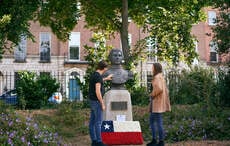Dr. Kevin Cahill's latest accomplishment, a retrospective on global outreach, as it concerns medical and humanitarian concerns, is currently being exhibited in New York.
A TV mini-series could be made about the adventures Dr. Kevin Cahill of New York has had in the various countries he has worked in. (After his wife Kate died in 2004, he calculated that he had worked in 65 countries. She had been to 45 of them with him.)
His latest accomplishment is a retrospective on global outreach, a look at how millions in the Third World, in this case, Somalia, somehow survive and the role of medical and humanitarian intervention. It is on display at the Exhibit and Study Center at Lenox Hill Hospital in New York.
Read more: How an Irish American doctor changed forever the training of humanitarian workers
Somali is just one country for which he and his program at Lenox Hill hospital in concert with Fordham University’s Institute of International Affairs has trained thousands of physicians and missionaries for work among the poorest of the poor.
The exhibit mostly features his own time in Somalia a country he says he witnessed both the birth and death of due to tribal and ethnic warfare
He began visiting Somalia, every year for 35 years, beginning in 1962. Does it depress him that Somalia has not seen the lives of its people improve in over five decades? “Somalia is an example of a country that I was there for when it was born, and I was there when it died,” he said. “It’s had no real functional schools since 1992. It’s an appalling story because it was really a very wonderful place when I first went there.”
During those years he defined diseases of Nomad tribes, took part in relief work after drought and famine and organized vast refugee camps.
There is as an extraordinary photograph of his own work there, showing a heavily pregnant woman with major complications a death sentence in Somalia. Tending to her is Cahill about to intervene and save her life. As a metaphor for a sick and ailing African country, it is particularly poignant as Cahill was the only doctor for hundreds of miles.
The exhibit is engrossing, a beautiful silver bridal belt, an antique nomad’s headrest, primitive musical instruments, artifacts that were old when time began-- it takes you to an exotic yet tragic place,
When asked how he won the trust of Somalis Cahill quotes a Somali song of praise
“Who welcomes you like a kinsman
And who at the height of drought
Does not bar his gate against you
Is not he who does not fail you in your weakness one of your brethren?"
Wonderful words captured also, in a commencement address back in 2008 when he told the graduate students of The College of the Holy Cross, in Worcester, Mass to see and feel beauty even in the most dreadful of places.
“Amid the fetid stenches of Indian urban decay, I mainly recall the strong aroma of exotic spices. I closed my eyes but usually saw saffron robes rather than soiled rags . . . I have been caught behind the lines in armed conflicts and seen senseless slaughter from Beirut to Managua, to Somalia and all across the scarred landscape of modern Africa. Somehow in the twisted wreckage of war, and in the squalor of refugee camps, the incredible beauty of humanity prevailed for me.”
Dr. Cahill has been a colossal force in the world of humanitarianism for many years. he was the president of the Center for Humanitarian Health and Co-operation in New York City; He is the director of the Institute of International Humanitarian Affairs at Fordham University (from which he graduated in 1957); the director of the Tropical Disease Center at Lenox Hill Hospital; former chief medical advisor to the president of the United Nations General Assembly; and former president of the American Irish Historical Society.
Read more: The Irish American doctor who led the fight to tackle AIDS
The doctor, who has five sons and nine grandchildren, first visited Ireland when he was thirteen. “I used to go back more often,” he explained. “But I’ve always stayed in very close touch.”
His grandfather came to the U.S. and became a policeman. He moved through the force from mounted horse corps, to street patrol, to captain, to eventually becoming the NYPD’s first director of the communications center, where he supervised a handful of Morse code operators in a single, sparse room. (A picture of his grandfather in that room lies in Dr. Cahill’s office so that he will never forget “from where I am sprung.”)
The family settled in Edenwald, the Bronx. His father went on to medical school – the day he died, Dr. Cahill himself entered Cornell Medical School. Although he was awarded a medical school scholarship, there was no extra money for a room, board or books. So, he worked as a chemistry lab technician several nights a week from 9 p.m. to 6 a.m. and then went to class from 9 a.m. to 5pm.
In 1959, he won a Lehman traveling fellow to the Far East. In India, he worked with a then “unknown Albanian nun in her Hospice for the Dying.” The world would know her in later years as Mother Teresa. Throughout rural Asia, he saw “death and disease on a vast scale,” and “returned completely and forever changed.”
He is still changing lives as the exhibit shows spearheading the medical missionaries who go to Africa.
The exhibit is at the Exhibit and Study Centre at Lenox Hill. To know more call 914 419 3077.
Read more: Our experience in the US mental health services and how I lost my husband




Comments